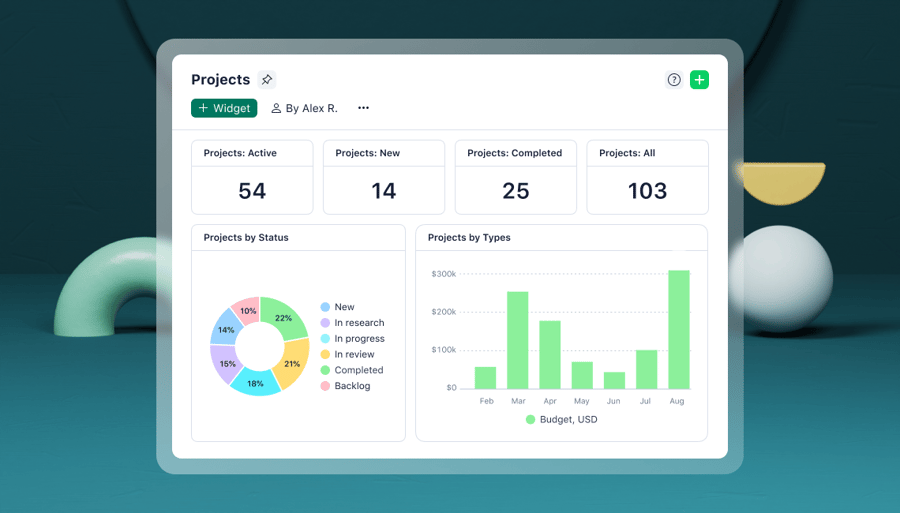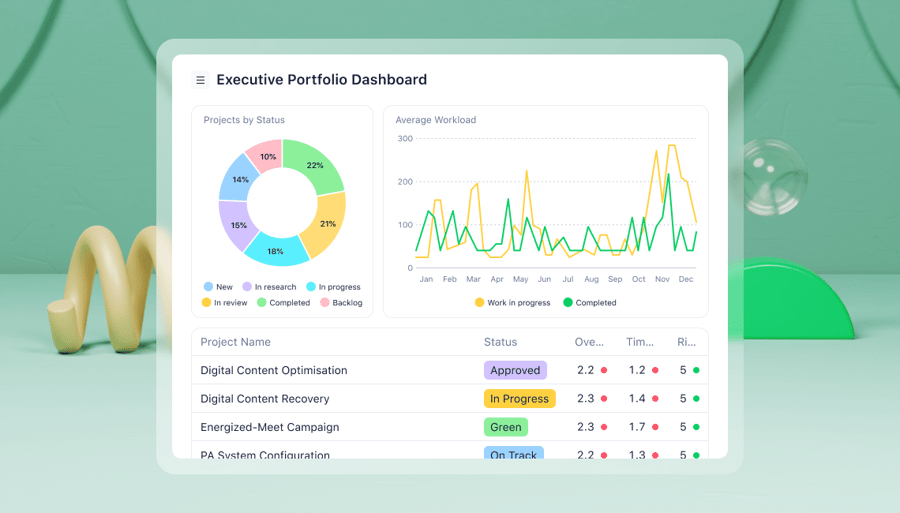Key takeaways:
- What is Project Portfolio Management (PPM)? PPM is a consolidated approach to managing and analyzing multiple projects to improve ROI and align with strategic business goals.
- What are the challenges of Enterprise Portfolio Management? Common challenges include governance conflicts, long delays, missed deadlines, and financial management issues due to resource conflicts.
- What is the role of a Portfolio Project Manager? The Portfolio Project Manager oversees projects from start to finish, creating processes, utilizing software, and ensuring communication among stakeholders.
- Why should anybody use PPM tools? PPM software enhances visibility, resource management, and decision-making, ensuring projects align with organizational objectives and deadlines are met.
- What is the best PPM software? Wrike is highly recommended for its user-friendly features, including dashboards, templates, and risk reporting capabilities that facilitate effective portfolio management.
Project portfolio management (PPM) is a fast-growing industry with a value of more than $2.9 billion in 2019. Over the next seven years, this market and the tools that power it are expected to grow at a compound annual rate of 13.4%. Which means now is a great time to learn about it and get ahead of the curve. In this complete project portfolio management guide, we’ll go over the basics then dive deeper into actionable tips. We’ll also tell you all about the only tool you need to master PPM.
What is project portfolio management?
Project portfolio management is a method used by organizations to plan schedules and allocate resources needed to bring a project portfolio to success.
Project portfolio management is, in essence, project management on a larger scale. This is because it concerns groupings of projects bundled into work portfolios. PPM is a system for analyzing the ROI, performance, and risks of each project portfolio so that the right work can be prioritized.
The difference between project and portfolio management is that project management focuses on individual projects while portfolio management oversees all projects at once.
What are the objectives of project portfolio management?
The objectives of project portfolio management include figuring out what’s working, what isn’t, and how companies can streamline their efforts.
Enterprise project portfolio management is a way for large corporations to manage and evaluate a large number of projects by grouping them into strategic portfolios. These portfolios are then analyzed for overall effectiveness, how their estimates compare with actual costs, and whether they align with the larger, strategic objectives of the organization.
In effect, it’s a data-driven process using lessons learned to help a company decide which types of projects to keep doing or stop doing.
The process involves executives regularly reviewing portfolios to decide which ones make the cut. They look at how the budget is spent, how much value and ROI each project portfolio delivers, and they ensure there are enough resources to go around. Executives closely monitor the progress of project portfolios in real-time by using enterprise project portfolio management software that compares current data with past data.
Enterprises that engage in project portfolio management are typically bombarded by:
- An overwhelming number of simultaneous projects that do not deliver value to the organization, often due to a lack of focus
- Projects that don’t support larger, company-wide business goals
- Projects that are massively delayed, leading to uncollected revenue and delayed ROI
- Resource conflicts, most notably when people are assigned to simultaneous projects — resulting in bottlenecks and delays
The entire point of enterprise project portfolio management is to improve the bottom line by eliminating project portfolios that drain resources and do not contribute to the health of the enterprise.
However, you may encounter several challenges running a professional services business.
What are the challenges of enterprise portfolio management?
The most common challenges of enterprise portfolio management revolve around project execution, resource allocation, and risk management. When your enterprise is managing complex, large-scale efforts made up of simultaneously running projects, you will face difficulties such as:
- Governance and oversight conflicts. While projects might survive with a simple structure (e.g. a project manager, a senior exec, and a business sponsor), entire portfolios will require more complex governance involving far more stakeholders spread out across several departments.
- Long delays and missed deadlines. A huge number of projects occurring simultaneously resulting in resource conflicts, bottlenecks, and delays. With tasks running in parallel, planning and managing a project portfolio requires serious administration, coordination, and leadership skills.
- Financial management issues. Proposed projects that don’t roll up to support company-wide business goals. Projects are massively delayed, which negatively affects revenue and ROI — proving they could benefit from project portfolio management software.
But there is a major upside. Once the process is set in motion and strategy is infused into all project-related expenditures across the enterprise, projects align better with enterprise goals.
When projects support a larger strategy, portfolios perform better from an economic standpoint — giving the enterprise a better overall return on investment. This is where the right tool can come in to help ensure the needed efficiency of the company.
What is the role of a portfolio project manager?
A portfolio project manager’s role in any assignment is to plan and oversee a project through from concept to completion. They’ll create processes, use project management software to organize teams, and communicate with all project stakeholders.
As large scale portfolios are tracked and analyzed, more responsibilities are placed on the shoulders of those authorizing, recording, and reporting these expenditures. It means more room for error, and therefore more need to conform to regulations regarding expenses.
The project portfolio management process
The process of managing a project portfolio is complex, to say the least. In addition to developing a plan that achieves everyone’s goals, a great project portfolio management process will include how the organization will measure success.
The process will also include a clear strategy, a process for tracking key performance indicators, and a strong communication system so that no voice goes unheard. But the most important step in the project portfolio is, without a doubt, risk management.
Top tips for portfolio risk management
Project portfolio risk management is all about decreasing the opportunities for failures like missed delivery dates and overspending. Here are some actionable ways to excel at portfolio risk management no matter how much experience you have:
- Take all worst-case scenarios seriously, especially if they seem unlikely. Low probability doesn’t mean it won’t happen. Failing to plan for the unlikely could lead to even bigger problems down the road.
- Remember to look at dependencies too. If project components rely on each other and something goes wrong, it can create a ripple effect.
- Risks have different levels of impact based on when they occur throughout projects. Consider what you’ll do to lessen an identified risk at each major project phase just in case.
- Create actionable plans with instructions project managers can easily understand and implement.
- Remember to calculate the effort put into executing risk management plans. Recovering from a specific risk may take up more resources than simply moving in a new direction.
What are the benefits of project portfolio management tools?
For organizations with many simultaneous projects, the benefits of project portfolio management software is that it ensures all projects have the right manpower to be accomplished by the agreed-upon deadline while staying within budget. The software can also be used to benchmark and then forecast future resource needs, determine the ROI of project commitments, and manage potential risk.
Project portfolio management solutions can also handle administrative functions, such as monitoring the workloads of team members, tracking billable hours, and managing change requests. In short, the right PPM software helps teams overcome the many challenges that companies face.
The entire point of PPM is to improve the bottom line by prioritizing the project portfolios that add value and contribute to the health of the organization. And when you use the right software for the job, you can do this at a much faster pace.
- More transparency leads to smarter decisions
Project portfolio management software gives your teams transparency into work. Suddenly, the entire breadth of projects can be seen by the organization. This means you can make smarter, fact-based decisions on your work, instead of making decisions based on gut feelings alone. It also means you can better align projects with company objectives. - Better visibility means efficient resource management
PPM software gives you more visibility for better resource management. When you can see who is working on what now and in the future, you can plan the distribution of your project portfolios accordingly and wisely. Goodbye, bottlenecks and delays. - Real-time access means better tools for reporting & analysis
Cloud-based project portfolio management software gives you real-time access to what work is being accomplished. You have the capability to produce timely reports and real-time analysis. Good PPM software also provides functionality for upper managers, such as portfolio budgeting, portfolio coordination, and ROI/forecasting, all of which contribute to getting a better handle on your project portfolios.
Introducing the best enterprise project portfolio management software
Wrike is the best enterprise project portfolio management software. Our robust solution tackles every aspect of project portfolio management with user-friendly tools such as:
- Built-in templates that standardize processes so you can duplicate success and adjust when needed without reinventing the wheel every time.
- Project matrices that breakdown risks and identify key categories, probabilities, and impacts.
- Dashboards that help you monitor risks and progress across all projects at the same time.
- Reporting tools that can be customized to automatically capture risk data and predict project outcomes for a variety of worst-case scenarios.
- Team collaboration features like @mentions that directly loop in stakeholders and give you greater insight into how teams work together day to day.
Master project portfolio management with Wrike
Project portfolio management is a hot industry for a reason. Through resource allocation, scheduling, and project planning, project portfolio managers can overcome major challenges. If you want to master this complex skill set, follow our tips and give Wrike’s enterprise portfolio management software a try. Use our free two-week trial to create visual timelines and tasks that help you better manage risks across many different projects all at once.









